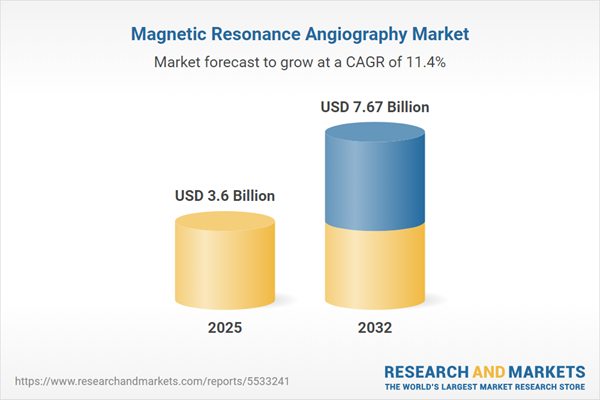Speak directly to the analyst to clarify any post sales queries you may have.
The magnetic resonance angiography market is advancing rapidly as global healthcare providers seek safer, noninvasive vascular imaging tools. Evolving technology and regulatory initiatives, alongside shifting economic dynamics, are shaping the competitive landscape and opportunities for key stakeholders.
Market Snapshot: Growth Trajectory of the Magnetic Resonance Angiography Market
The magnetic resonance angiography market grew from USD 3.23 billion in 2024 to USD 3.60 billion in 2025. Rising at a CAGR of 11.38%, the market is projected to reach USD 7.67 billion by 2032.
Scope & Segmentation: Comprehensive Analysis of Market Dimensions
This report delivers an in-depth analysis, segmenting the magnetic resonance angiography market by product, field strength, technology, application, end user, region, and key company participants.
- Product: Accessories and Consumables, Service, High Field Strength System, Low Field Strength System
- Field Strength: High Field Strength, Low Field Strength
- Technology: Contrast Enhanced, Phase Contrast, Quiescent Interval Single Shot, Time Of Flight
- Application: Cardiovascular (Aortic, Cardiac), Neurovascular (Extracranial, Intracranial), Peripheral Vascular (Lower Limb, Upper Limb)
- End User: Academic Research Institute, Ambulatory Surgical Center, Diagnostic Imaging Center, Hospital
- Geography: Americas (United States, Canada, Mexico, Brazil, Argentina, Chile, Colombia, Peru), Europe, Middle East & Africa (United Kingdom, Germany, France, Russia, Italy, Spain, Netherlands, Sweden, Poland, Switzerland, United Arab Emirates, Saudi Arabia, Qatar, Turkey, Israel, South Africa, Nigeria, Egypt, Kenya), Asia-Pacific (China, India, Japan, Australia, South Korea, Indonesia, Thailand, Malaysia, Singapore, Taiwan)
- Key Companies: Siemens Healthineers AG, GE Healthcare, Inc., Koninklijke Philips N.V., Canon Medical Systems Corporation, Hitachi, Ltd., Fujifilm Holdings Corporation, United Imaging Healthcare Co., Ltd., Samsung Medison Co., Ltd., Shimadzu Corporation, Esaote S.p.A.
Key Takeaways: Strategic Insights for Senior Decision-Makers
- Continuous innovation in scanner hardware and imaging software improves anatomical detail, supporting more accurate diagnostics and patient monitoring.
- Adoption of AI solutions and open gantry scanner designs fosters enhanced clinical utility, improving workflow efficiency and patient experience.
- Evolving reimbursement models and value-based care frameworks are encouraging broader integration of advanced noninvasive imaging protocols.
- Regional differences in regulatory alignment, funding, and healthcare infrastructure affect the pace and scale of market adoption.
- Sustainable ecosystem growth is increasingly driven by collaboration among technology leaders, clinical providers, and regional distributors.
Tariff Impact: Navigating Shifting Costs and Supply Chain Risks
Recent United States tariff measures on core components such as gradient coils and superconducting wires have increased operational costs and impacted supply timelines. Manufacturers and providers have responded by diversifying sourcing, renegotiating contracts, and investing in modular upgrade paths to maintain clinical competitiveness and mitigate risk exposure. Partnerships with domestic fabricators and industry advocacy for tariff exemptions are influencing medium-term supply chain resilience.
Methodology & Data Sources
This report is underpinned by qualitative interviews with key market stakeholders and secondary analysis of regulatory filings, clinical studies, and industry publications. Findings are cross-validated through segmentation-driven data triangulation and iterative expert reviews, ensuring credible market trends and actionable conclusions.
Why This Magnetic Resonance Angiography Market Report Matters
- Enables senior decision-makers to benchmark technology adoption and competitive positioning across target regions and end-user settings.
- Provides clarity on segment dynamics, emerging regulatory shifts, and the strategic implications of supply chain changes.
- Equips stakeholders with intelligence to foster innovation, guide capital allocation, and prioritize growth initiatives in an evolving imaging market.
Conclusion
Strategic focus on advanced imaging capabilities, supply chain resilience, and regulatory alignment will define future success in the magnetic resonance angiography market. Stakeholders equipped with timely, actionable insights will be better positioned to drive clinical outcomes and strengthen market presence.
Additional Product Information:
- Purchase of this report includes 1 year online access with quarterly updates.
- This report can be updated on request. Please contact our Customer Experience team using the Ask a Question widget on our website.
Table of Contents
3. Executive Summary
4. Market Overview
7. Cumulative Impact of Artificial Intelligence 2025
Companies Mentioned
The companies profiled in this Magnetic Resonance Angiography market report include:- Siemens Healthineers AG
- GE Healthcare, Inc.
- Koninklijke Philips N.V.
- Canon Medical Systems Corporation
- Hitachi, Ltd.
- Fujifilm Holdings Corporation
- United Imaging Healthcare Co., Ltd.
- Samsung Medison Co., Ltd.
- Shimadzu Corporation
- Esaote S.p.A.
Table Information
| Report Attribute | Details |
|---|---|
| No. of Pages | 199 |
| Published | October 2025 |
| Forecast Period | 2025 - 2032 |
| Estimated Market Value ( USD | $ 3.6 Billion |
| Forecasted Market Value ( USD | $ 7.67 Billion |
| Compound Annual Growth Rate | 11.3% |
| Regions Covered | Global |
| No. of Companies Mentioned | 11 |









